ENVIRONMENTAL MANAGEMENT CONCEPT FOR MALARIA CONTROL
Abstract
For along period, malaria control is based on drugs and insecticides, but their sustainability has been undermined by the development of resistance and growing concern about the long-term of environmental pollution of some insecticides. So, this method is only applied for a short period but on large scale using Dichloro-diphenyl trichloroethane (DDT) till about 1960s. In Indonesia, It was conducted for a large scale in eradicating malaria lead to a low level of prevalence. In the early 1900s malaria was controlled in many part of the region using environmental management (EM). EM is where the environment modified or manipulated to reduce malaria transmission by attacking local vector mosquitoes and requires an understanding of the ecology of its species. To be successful EM requires co-ordination and collaboration among different related government institutions, non government organizations (NGOs), and public sectors. It also aims to raise awareness of the wide array of opportunities that exist to design , construct and operate infrastructure as a sustainable means of reducing malaria transmission risks in specific settings. EM offers exciting new opportunities for sustainable malaria control as part of an integrated approach to malaria management.
Keywords: Environmental management, malaria control.
Refbacks
- There are currently no refbacks.
Organized by Department of Public Health, Faculty of Public Health, Universitas Sriwijaya. Website design © 2017
 Jurnal Ilmu Kesehatan Masyarakat (JIKM) published by Public Health Faculty Sriwijaya University is licensed under a Creative Commons Attribution-NonCommercial-ShareAlike 4.0 International License.
Jurnal Ilmu Kesehatan Masyarakat (JIKM) published by Public Health Faculty Sriwijaya University is licensed under a Creative Commons Attribution-NonCommercial-ShareAlike 4.0 International License.













